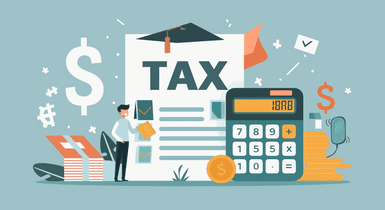Child Tax Credit: Detailed Overview
Contents

Thanks to a Child Tax Credit (CTC), about 40 million families are provided with annual financial support. It has proven to be one of the most effective tools in reducing child poverty, significantly improving the lives of countless families across the US.
How does the Child Tax Credit work? And how do you know if you qualify for it? If you need help figuring it out, this article is for you.
What Is the Child Tax Credit?

The Child Tax Credit is a refund that taxpayers can claim for having a dependent child aged 17 or younger. This credit provides a dollar-for-dollar reduction in tax liability. However, to be eligible for this refund, a taxpayer must meet certain criteria, such as income level, the child’s age, and their relationship to the individual filing the claim. If your income surpasses a specified threshold, you may either receive a reduced credit or no credit at all.
How Much Is the Child Tax Credit For 2024?

If your MAGI is $200,000 or less (or $400,000 if you are married and file taxes jointly), you will receive a $2,000 Child Tax Credit per year for each qualified dependent kid for 2024 (for taxes paid in 2025). The credit amount is lower for wealthier families. When income exceeds the limit, the credit is lowered by $50 until it’s canceled altogether.
This year, the refundable part, commonly referred to as the additional Child Tax Credit, will increase in value to a maximum of $1,700.
Who Qualifies for the Child Tax Credit?

To get the refund, you’ll have to meet all the Child Tax Credit requirements. You and your kid must typically pass seven “tests.”
- Age: Your child must be younger than 17 at the end of the fiscal year.
- Relationship: The kid must be your biological or adopted child, sibling, half-brother, half-sister, grandchild, niece, or nephew.
- Dependent status: You must legally and correctly claim the kid as a dependent. Additionally, the kid is not permitted to submit a joint tax return unless they do so in order to get a reimbursement for taxes that were estimated or withheld.
- Citizenship status: To qualify for the CTC, the IRS requires that your child possess a valid Social Security number and meet one of the following criteria: be a US citizen, US national, or US resident alien.
- Residency: Generally, the kid must have resided with you for at least six months during the tax year. Certain exceptions may apply under specific circumstances.
- Financial support: You must have provided more than 50% of your child’s financial support over the course of the year. Otherwise, you probably wouldn’t meet Child Tax Credit eligibility requirements.
- Income threshold: The credit is subject to income limits. If your annual income exceeds these limits, the CTC may be reduced or even unavailable for you.
How to Get the Child Tax Credit?

Americans claim this credit while filing for tax refund on IRS Form 1040 or 1040-SR. To apply, you must gather the required documentation: proof of income, your dependent’s Social Security number, and documentation proving your dependent lived with you for at least six months.
After that, the Child Tax Credit will be claimed on Schedule 8812, which is attached to your Form 1040. This schedule determines the credit amount for which you qualify, taking into account your income and the number of eligible children. It is crucial that the information provided aligns with your tax records and includes accurate Social Security numbers for each kid.
Once your tax return is filed, whether electronically or by mail, the IRS will review your submission and apply the CTC to reduce your overall tax liability. If you qualify for a refund, it will be issued upon completion of your return processing.
If you struggle with filing the kids tax credit, use tax software. There are many programs designed to help you calculate CTC and ensure you don’t miss any important steps. If your tax situation is complex, consult a tax professional to make sure you claim the full Child Tax Credit amount.
Typical Mistakes and Their Consequences

If the IRS finds an issue with your request, you may face a penalty of up to 20% of the refund amount claimed.
1. Claiming Ineligible Children
Taxpayers sometimes try to get CTC for kids who don’t meet the IRS’s Child Tax Credit requirements. To qualify, a dependent must meet criteria related to age, relationship, residency, and support. That’s why you should review the IRS eligibility rules carefully. The child must be under 17 years old by the end of the tax year, have resided with you for more than half of the year, and possess a valid Social Security number.
2. Wrong Last Name or Social Security Number
One of the most common mistakes when claiming the CTC is providing an incorrect Social Security Number for the qualifying child or incorrectly spelling their last name. Always double-check the SSN and the last name on your child’s Social Security card and ensure it matches what is reported on your tax return.
3. Claiming the Same Child Twice
Divorced parents often mistakenly claim the same minor on both of their tax returns. Generally, only one parent can claim the CTC for a given child in a tax year. This is usually the parent with whom the child lived most of the year.
If both parents claim the credit, the IRS will flag both returns. This can delay refunds and result in audits or penalties for the incorrect claimant. Make sure there is an agreement about who will claim the kid if you are divorced or separated. Sometimes, Form 8332 can be used to assign credit to a noncustodial parent.
4. Wrong Filing Status
You cannot use the single filing status to claim the EITC if you are married. Married people who resided with their CTC eligible kids during the later half of 2023 can’t claim the EITC under the head of the family filing status.
5. Claiming the Credit After Income Phaseouts
Trying to claim the full credit when your income exceeds the limits is another common mistake. In this case, the IRS will reduce or deny the credit, which may lead to an unexpected tax bill. Remember to provide proof of income, such as Forms 1099-NEC, 1099-MISC, W-2, and W-2G.
To summarize, CTC can provide significant financial relief to families with children under 17. Understanding the eligibility requirements, including age and income limitations, as well as the forms you must submit, can help lower your tax bill and possibly qualify you for a refundable credit. However, it’s essential to pay attention to details like the kid’s Social Security number and eligibility to avoid costly mistakes.




